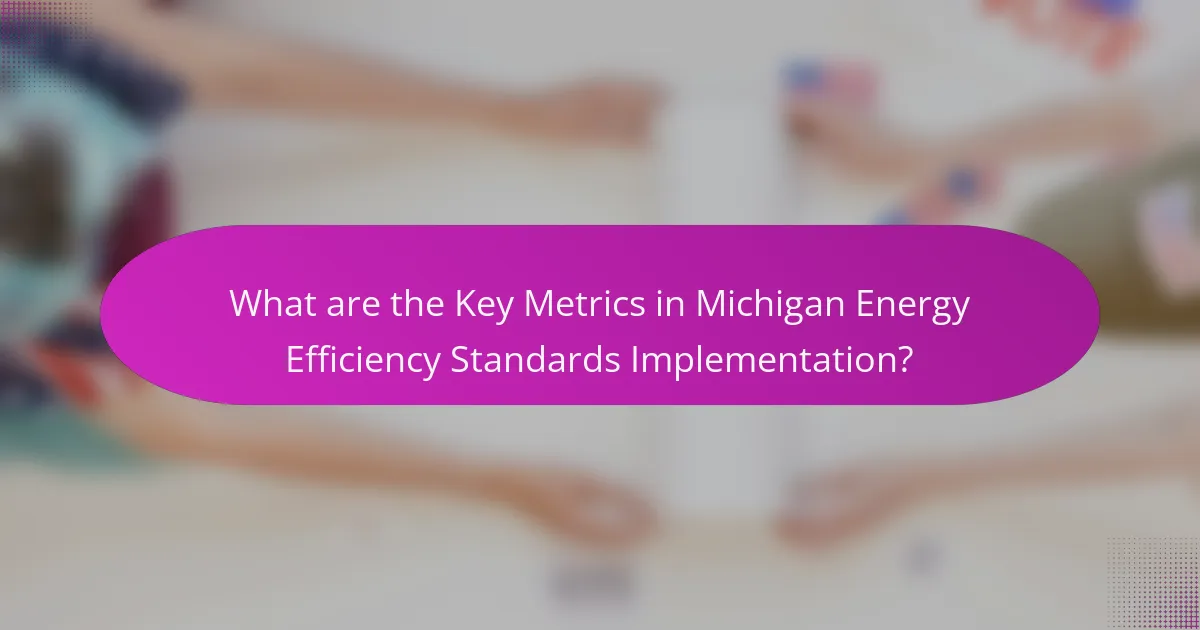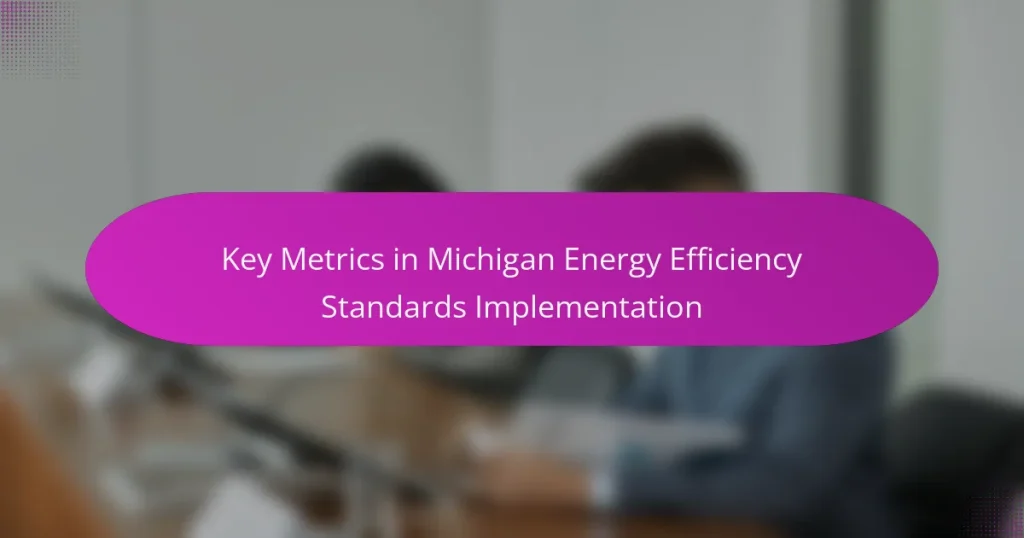
What are the Key Metrics in Michigan Energy Efficiency Standards Implementation?
Key metrics in Michigan energy efficiency standards implementation include energy savings, cost-effectiveness, and program participation rates. Energy savings are measured in kilowatt-hours (kWh) or therms, quantifying the reduction in energy consumption. Cost-effectiveness evaluates the financial benefits of energy savings compared to the program costs. Program participation rates indicate the number of customers engaged in energy efficiency programs. Additional metrics include peak demand reduction and environmental impact assessments. These metrics collectively assess the effectiveness of energy efficiency initiatives in Michigan.
Why are Key Metrics important in Energy Efficiency Standards?
Key metrics are crucial in energy efficiency standards because they provide measurable benchmarks for performance. These metrics help assess the effectiveness of energy-saving measures. They enable comparison across different programs and technologies. Accurate metrics inform decision-making for policymakers and stakeholders. For example, metrics like energy savings per dollar spent guide investment strategies. Additionally, they ensure accountability and transparency in energy programs. Effective tracking of these metrics can lead to improved energy efficiency outcomes. In Michigan, adherence to key metrics has shown significant reductions in energy consumption and costs.
How do Key Metrics influence policy decisions in Michigan?
Key metrics influence policy decisions in Michigan by providing data-driven insights for energy efficiency standards. These metrics evaluate performance, cost-effectiveness, and environmental impact. Policymakers use metrics to assess program effectiveness and allocate resources efficiently. For example, energy savings data directly informs funding decisions for energy programs. Metrics like cost per kilowatt-hour saved guide the prioritization of projects. Additionally, metrics help track progress toward state energy goals. This ensures accountability and transparency in energy policy implementation. Accurate metrics lead to informed decisions that enhance Michigan’s energy efficiency initiatives.
What role do Key Metrics play in measuring success?
Key metrics are essential for evaluating success in energy efficiency standards implementation. They provide quantifiable data that enables stakeholders to assess progress. These metrics can include energy savings, cost reductions, and program participation rates. By tracking these figures, organizations can identify areas for improvement. For instance, a study by the American Council for an Energy-Efficient Economy found that effective metrics lead to a 20% increase in program effectiveness. This demonstrates that key metrics not only measure success but also drive strategic decisions.
What are the primary Key Metrics used in Michigan?
The primary key metrics used in Michigan for energy efficiency standards implementation include energy savings, demand reduction, and cost-effectiveness. Energy savings are typically measured in megawatt-hours (MWh) saved annually. Demand reduction metrics focus on peak demand reductions in kilowatts (kW). Cost-effectiveness is assessed through the Total Resource Cost (TRC) test, which compares program costs to the benefits of energy savings. These metrics guide policy and program decisions in Michigan’s energy sector.
What is the significance of energy savings as a Key Metric?
Energy savings is significant as a key metric because it quantifies the reduction in energy consumption achieved through efficiency measures. This metric helps track progress towards energy efficiency goals. It also provides a basis for evaluating the effectiveness of energy programs. According to the Michigan Public Service Commission, energy savings can lead to lower utility bills for consumers. Additionally, it contributes to reduced greenhouse gas emissions. The American Council for an Energy-Efficient Economy emphasizes that every kilowatt-hour saved directly impacts overall energy demand. Thus, energy savings serve as a critical indicator of both economic and environmental benefits.
How is customer participation measured as a Key Metric?
Customer participation is measured as a key metric through various quantitative methods. These methods include surveys, participation rates, and feedback mechanisms. Surveys assess customer awareness and engagement levels. Participation rates track the number of customers involved in energy efficiency programs. Feedback mechanisms gather insights on customer satisfaction and program effectiveness. For instance, in Michigan, the Michigan Public Service Commission reports participation data annually. This data helps evaluate the success of energy efficiency initiatives. Accurate measurement of customer participation informs program adjustments and improvements.
What are the cost-effectiveness metrics in energy efficiency?
Cost-effectiveness metrics in energy efficiency evaluate the economic benefits of energy-saving measures. Common metrics include the Benefit-Cost Ratio (BCR), which compares the benefits of energy savings to the costs incurred. The Total Resource Cost (TRC) test assesses the overall cost-effectiveness from the perspective of all participants, including utility providers and consumers. The Program Administrator Cost (PAC) test focuses on the costs and benefits to the program administrator. The Societal Cost Test (SCT) considers broader societal impacts, including environmental benefits. These metrics guide decision-making in energy efficiency programs, ensuring that investments yield favorable economic returns. Studies show that effective energy efficiency programs can lead to significant cost savings, with some programs reporting a BCR greater than 2:1.
How are Key Metrics collected and analyzed?
Key metrics are collected through systematic data gathering methods. These methods include surveys, energy consumption tracking, and performance assessments. Data is often sourced from utility companies, government reports, and direct measurements. Analysis involves statistical techniques to interpret the collected data. Common analysis methods include regression analysis and trend analysis. These techniques help identify patterns and correlations in energy usage. The Michigan Energy Efficiency Standards Implementation utilizes these metrics to evaluate program effectiveness. Regular reporting ensures transparency and accountability in energy efficiency initiatives.
What data sources are used for Key Metrics in Michigan?
Key metrics in Michigan are derived from various data sources. These include the Michigan Public Service Commission reports. Utility company data also plays a crucial role. Additionally, energy consumption surveys provide vital information. The U.S. Energy Information Administration data is frequently referenced. Academic research and studies contribute to understanding energy efficiency. These sources help in assessing the effectiveness of energy efficiency standards in Michigan.
How is data integrity ensured in Key Metrics collection?
Data integrity in Key Metrics collection is ensured through several systematic processes. First, standardized data collection methods are implemented to maintain consistency. This includes using predefined protocols for data entry and validation. Second, regular audits and reviews of collected data are conducted to identify and rectify discrepancies. Third, automated data integrity checks are employed, such as validation rules and error alerts during data entry. Additionally, training for staff involved in data collection is provided to minimize human errors. These practices ensure that the data remains accurate, reliable, and valid for analysis.

What challenges are associated with implementing Key Metrics?
Implementing Key Metrics faces several challenges. One major challenge is the lack of standardized definitions for metrics. This inconsistency can lead to confusion and misinterpretation. Another challenge is data collection and accuracy. Gathering reliable data is often resource-intensive and may not be feasible for all stakeholders. Additionally, aligning metrics with diverse stakeholder goals can create conflicts. Different organizations may prioritize varying outcomes, complicating consensus. Furthermore, there is often resistance to change within organizations. Stakeholders may be hesitant to adopt new metrics due to established practices. Lastly, ongoing monitoring and adjustment of metrics is necessary. This requires continuous effort and commitment from all parties involved.
What are the common obstacles in data collection for Key Metrics?
Common obstacles in data collection for key metrics include data availability, accuracy, and consistency. Limited access to reliable data sources often hinders effective analysis. Data accuracy can be compromised by human error or outdated information. Inconsistencies arise when different methodologies are used across various data sets. Additionally, resource constraints can limit the capacity to collect and analyze data effectively. A lack of standardized metrics further complicates the ability to compare data across different programs. These challenges can impede the evaluation of energy efficiency standards in Michigan.
How does lack of funding impact Key Metrics implementation?
Lack of funding negatively impacts Key Metrics implementation by limiting resources for data collection and analysis. Insufficient financial support restricts the ability to hire skilled personnel and invest in necessary technology. This leads to incomplete or inaccurate data, which undermines the reliability of the metrics. Without proper funding, the development of comprehensive reporting systems is hindered. Consequently, stakeholders may lack access to critical information needed for decision-making. Research indicates that organizations with adequate funding achieve better data-driven outcomes. In contrast, those with budget constraints often face challenges in meeting energy efficiency standards effectively.
What are the implications of stakeholder engagement on Key Metrics?
Stakeholder engagement significantly influences key metrics in Michigan’s energy efficiency standards implementation. Engaged stakeholders provide valuable insights that shape program design and execution. Their involvement often leads to improved program acceptance and participation rates. This increased participation can enhance energy savings metrics, reflecting more successful implementations. Furthermore, stakeholder feedback can identify areas for improvement, optimizing resource allocation and effectiveness. Research indicates that programs with active stakeholder involvement achieve better performance outcomes. For instance, a study by the American Council for an Energy-Efficient Economy found that stakeholder-driven initiatives resulted in 20% higher energy savings compared to those without such engagement.
How can these challenges be overcome?
Challenges in Michigan’s energy efficiency standards implementation can be overcome through targeted strategies. First, enhancing stakeholder engagement can ensure that all parties understand the benefits of energy efficiency. This includes utilities, consumers, and policymakers. Second, providing clear guidelines and support can help streamline compliance processes. Training programs for contractors and utilities can improve implementation. Third, leveraging data analytics can help track progress and identify areas for improvement. Regular assessments can ensure that strategies remain effective. Lastly, securing adequate funding for energy efficiency programs can facilitate broader adoption. Research indicates that states with strong financial support see higher participation rates in energy efficiency initiatives.
What strategies can enhance data collection processes?
Utilizing technology is a key strategy to enhance data collection processes. Implementing automated data collection tools can significantly improve accuracy and efficiency. For instance, sensors and smart meters can gather real-time data on energy usage. This reduces human error associated with manual data entry. Another effective strategy is standardizing data formats. Consistent formats facilitate easier data integration and analysis. Training staff on data collection methods also enhances the quality of collected data. Research shows that organizations investing in training see a 30% improvement in data accuracy. Additionally, engaging stakeholders in the data collection process can provide valuable insights. Collaboration can lead to more comprehensive data gathering and better outcomes.
How can stakeholder involvement be improved in Key Metrics?
Stakeholder involvement in Key Metrics can be improved by enhancing communication channels. Regular updates and transparent reporting can foster trust among stakeholders. Creating collaborative forums for discussion encourages input and feedback. Implementing surveys can gather stakeholder opinions on key metrics effectively. Establishing a stakeholder advisory group can ensure diverse perspectives are included. Training sessions can equip stakeholders with necessary knowledge about metrics. Utilizing technology for real-time data sharing can keep stakeholders engaged. These strategies have been shown to increase participation and satisfaction in similar initiatives.

What are the future trends in Key Metrics for Energy Efficiency?
Future trends in key metrics for energy efficiency include increased use of real-time data analytics and IoT technology. These advancements enable more precise monitoring of energy consumption patterns. Enhanced metrics will focus on energy performance indicators like energy use intensity (EUI) and carbon emissions. The integration of renewable energy sources will also shape future metrics. Energy efficiency programs will increasingly emphasize cost-effectiveness and return on investment (ROI). Regulatory frameworks will evolve, promoting standardized metrics across sectors. Additionally, consumer engagement metrics will gain importance, reflecting user behavior and feedback. These trends are driven by the need for sustainable practices and compliance with evolving regulations.
How is technology shaping the future of Key Metrics?
Technology is shaping the future of Key Metrics by enabling more accurate data collection and analysis. Advanced analytics tools allow for real-time monitoring of energy consumption. This leads to better forecasting and decision-making. Machine learning algorithms can identify patterns in energy usage. These insights help optimize efficiency measures. Additionally, smart grid technology enhances the integration of renewable energy sources. This shift promotes more sustainable energy practices. According to a report by the U.S. Department of Energy, smart grid technologies can improve energy efficiency by up to 30%. Thus, technology is a critical driver in evolving Key Metrics for energy efficiency standards.
What innovations are being explored in data analytics for Key Metrics?
Innovations in data analytics for Key Metrics include machine learning algorithms and predictive analytics. These technologies are being utilized to enhance the accuracy of energy consumption forecasts. Advanced data visualization tools are also being explored to present complex data in an understandable format. Real-time data processing is gaining traction to provide immediate insights into energy usage patterns. Additionally, integration of IoT devices is being examined to collect granular data from energy systems. Blockchain technology is being investigated for improving data security and transparency in energy transactions. These innovations aim to optimize energy efficiency and support informed decision-making in Michigan’s energy standards implementation.
How might regulatory changes influence future Key Metrics?
Regulatory changes can significantly influence future Key Metrics in Michigan’s energy efficiency standards implementation. These changes may alter compliance requirements for energy efficiency programs. For example, stricter regulations could necessitate more rigorous data collection and reporting. This would impact metrics related to energy savings and program effectiveness. Additionally, incentives or penalties introduced by new regulations may drive changes in consumer behavior. As a result, future Key Metrics may reflect increased energy savings or shifts in energy consumption patterns. Historical data indicate that regulatory updates often lead to adjustments in program designs and evaluation methods, thereby affecting the metrics used to assess success.
What best practices should be followed for effective Key Metrics implementation?
Effective Key Metrics implementation requires clear definition, consistent tracking, and regular review. First, define metrics that align with organizational goals and objectives. This ensures that the metrics are relevant and actionable. Next, establish a consistent tracking process to collect data regularly. This data should be accurate and timely to inform decision-making.
Additionally, involve stakeholders in the development of metrics. This promotes buy-in and ensures that different perspectives are considered. Regularly review and analyze the metrics to assess performance and identify areas for improvement. This iterative process allows for adjustments based on real-time data.
Finally, utilize visualization tools to present metrics clearly. Visual representations help communicate insights effectively to stakeholders. By following these best practices, organizations can enhance their Key Metrics implementation and drive better outcomes.
What are the key considerations for establishing effective metrics?
Key considerations for establishing effective metrics include clarity, relevance, and measurability. Metrics must be clearly defined to ensure everyone understands their purpose. Relevance ensures that metrics align with organizational goals and objectives. Measurability allows for tracking progress over time. Additionally, metrics should be actionable, providing insights that drive decision-making. Consistency in data collection methods is crucial for reliability. Finally, stakeholder input is essential to ensure metrics meet the needs of all parties involved. These considerations help create a robust framework for evaluating performance in energy efficiency standards implementation.
How can continuous improvement be integrated into Key Metrics processes?
Continuous improvement can be integrated into Key Metrics processes by establishing a feedback loop. This loop involves regularly reviewing performance data and identifying areas for enhancement. Setting specific, measurable objectives is essential for tracking progress. Utilizing tools like Plan-Do-Check-Act (PDCA) can facilitate structured improvement efforts. Engaging stakeholders in the evaluation process ensures diverse insights are considered. Training staff on best practices promotes a culture of continuous improvement. Regularly updating metrics based on lessons learned keeps the process dynamic. Data-driven decision-making supports effective adjustments to strategies and practices.
The main entity of the article is “Key Metrics in Michigan Energy Efficiency Standards Implementation.” This article provides a detailed overview of the essential metrics used to evaluate the effectiveness of energy efficiency initiatives in Michigan, including energy savings, cost-effectiveness, program participation rates, and environmental impact assessments. It highlights the importance of these metrics in guiding policy decisions, measuring success, and ensuring accountability in energy programs. Additionally, the article addresses challenges in data collection, stakeholder engagement, and the influence of technology and regulatory changes on future metrics, offering best practices for effective implementation and continuous improvement.


